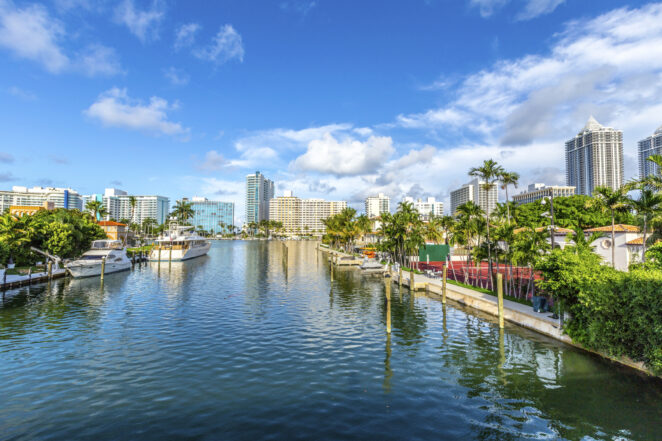Looking for a place that’s warm and sunny? For many, Miami is one of the top destinations if they need a little sun and sand to feel rejuvenated. While it is true that this city has plenty of sights and sounds to offer, what is it like for people who have chosen to stay long-term?
For working professionals, the emerging tech and cybersecurity scene is an exciting space to be in—and setting up in Miami also means putting some distance between them and the state income tax. In fact, the entire state of Florida does not have an income tax. This, alongside the promise of good weather, makes it incredibly attractive for people who are looking for a place with a lower cost of living.
But before you start looking through the properties in miami, take a quick look at the whole picture. Here’s what you need to know about living expenses in the area.
How Much Should I Earn to Live in Miami?
A comfortable life in Miami as a renter, as calculated by Go Banking Rates, can happen if you earn at least $77,057. This is assuming that you follow the common financial rule to spend about 50 percent of your after-tax income on necessities such as transportation, food, rent, healthcare, and utilities.
How Much Money Do I Need to Move to Miami?

You may find yourself falling for Miami’s charms after a work stint in the area, or perhaps you want to just take an extended trip so you can wait out the winter by the beach. If so, the average one-bedroom apartment in the area costs about $2,000 per month. Utilities for one person will fall somewhere around $150 per month, and $400 per month should be enough allocation for food and drink. However, this estimation does not give you plenty of room for dining out.
The cost of living in Miami can vary depending on factors such as your housing, transportation, and lifestyle choices. It’s a good idea to create a budget to help you plan for the costs involved in moving to Miami. This will help you determine how much money you need to save before making the move.
Factors Affecting Cost of Living in Miami
Commute and Transportation
Unfortunately, one of the downsides of moving to Miami is that you definitely need a car to get around the area. This area is known for its high vehicle ownership rates, with a staggering 91.7 percent of households owning at least one vehicle.
However, if you do not have a car just yet, Miami does offer public transportation in the form of the Metrobus. It operates more than 95 routes and has been designed to bridge the Metrorail and Metromover, which is the bus system across Miami-Dade County. This should be enough to get you to all the places you need to go, especially if you have found a place to stay near your work area.
The bus rides are fairly affordable and start at $2.25 per trip. The most straightforward way to pay for a bus is to get an EASY Ticket. The Metrorail fares are the same, and a Metrorail one-month pass is $112.50. A discounted fare also exists and is priced at $56.25.
Healthcare
On average, the cost of health insurance for a 40-year-old living in Florida is $571 per month. In this aspect, Miami is slightly more affordable than the rest of the country. The cost is 1.2 percent below the national average.
Education
You may have children who you send to school, or you are taking up education yourself. If so, the average tuition and fees for colleges in Miami run at $4,005 for in-state and $12,763 for out-of-state. The good news is that these numbers run lower than the national average for tuition and fees, which go at $5,540 for in-state students, and $17,871 for out-of-state students.
Food

On average, the cost of food for one person living in Miami will set them back at around $376.29. Interestingly, the price of groceries has been placed at 7.3 percent higher than the national average.
Taxes
The general state sales tax of Florida is 6 percent. It’s a fairly low rate that helps keep the cost of living at a lower threshold. For homeowners, property tax is based on the size of their property and the area where they live. Overall, the property tax here does run below the national average. If you plan on buying an apartment or house instead of renting in Miami, then you will need to consider real estate transfer tax.
Employment
New tech is not the only thing that Miami has gone through. The great weather has given Miami plenty of natural flair as a tourist destination, especially for the cruise industry. As a result, there are plenty of people who are employed in the service industry. You can find them working the numerous hotels, bars, restaurants, cruise ships, and the main airport.
To accommodate such a big and steady influx of workers, plenty of construction jobs have risen adjacent to the service industry.

Conclusion
There are many ways to earn a living in Miami. Some options might include finding a job in a specific industry or starting a business. Some industries that are popular in Miami include tourism, healthcare, finance, and real estate. It is also a diverse city with a large immigrant population, so there may be opportunities to use language skills or cultural knowledge in a career.
Additionally, Miami is home to many startup companies and small businesses, so entrepreneurship is another option for earning a living in the city.
The best way to earn a living in Miami will depend on your skills, interests, and experience. It might be helpful to research job opportunities in the area to get a sense of what is available and what industries are in demand. It’s also a good idea to network with people in your field of interest and to consider taking classes or earning additional certifications to increase your chances of finding employment.




